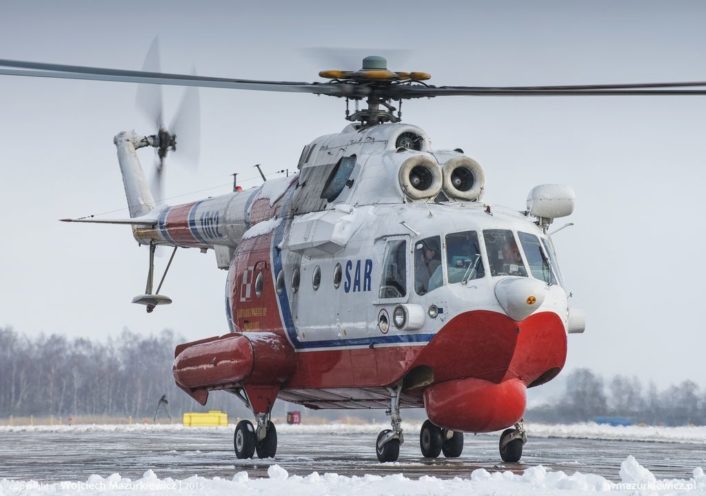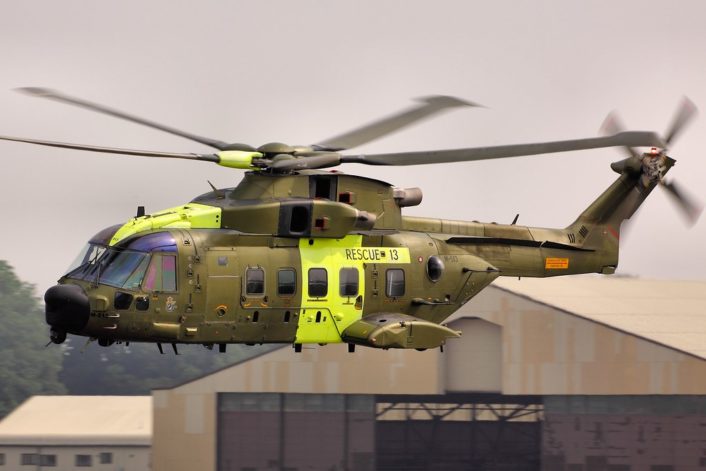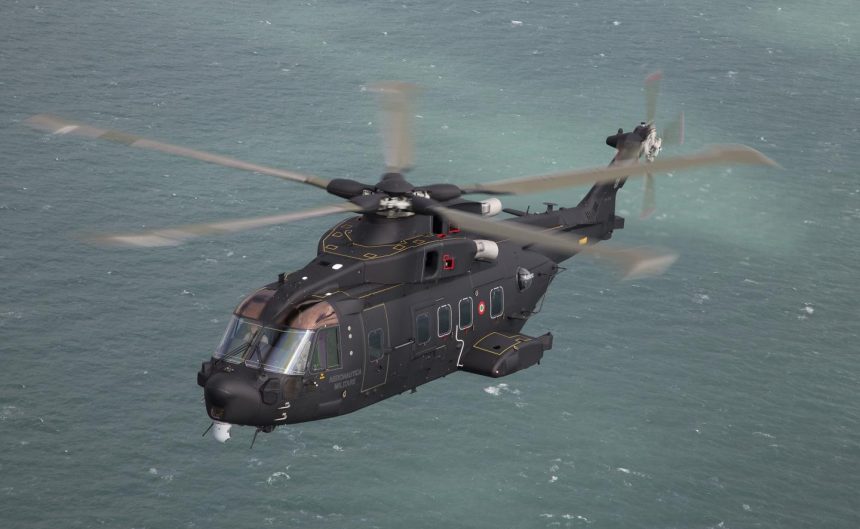The procurement did spark a lot of controversy.
On Apr. 26, Leonardo announced the signing of a contract valued at approximately 380 mln EUR (1.65 bn PLN) “that will significantly enhance the Polish Navy’s helicopter capability. Through its fully owned Polish company and main industrial presence in the country, PZL-Świdnik, Leonardo will supply four AW101s and a comprehensive integrated logistics and training package to the Polish Ministry of National Defence (MoD). PZL-Świdnik, acting as the prime contractor and responsible for the entire contract execution, was selected in a multi-stage process, meeting all the requirements of the Polish MoD, and will deliver and support the most capable maritime multirole helicopter available on the market today. The helicopter is already in service in some of the most important NATO nations among others. The Świdnik facility plays a significant role in the production of all the AW101s ordered worldwide,” says Leonardo’s press release.
As many Polish media outlets recalled last week, in 2016, when Poland decided to scrap the planned purchase of 50 Airbus Helicopters EC725 Caracals, after offset negotiations failed, the Law and Justice (PiS) government that currently remains in power in Poland suggested that their predecessors, the Civic Platform (PO), was trying to procure the most expensive helicopter ever manufactured (literally, an argument as such was used). Now, the new government is procuring a helicopter platform that is even more expensive – the AW101 – with a caricature of an offset agreement entailed. And furthermore, the governing party is also fighting the Polish defense domain journalists reporting on the matter, trying to prove that the helicopter acquisition made last week is a major feat and they are making tough effort to present the procurement as a success.
Not too long ago we have reported that the situation in the Polish Naval aviation is far from perfect. The Polish Navy currently operates W-3 WARM Anakonda helicopters for SAR purposes that are not sufficient to carry out the task in any weather conditions, performance-wise, along with two variants of Mi-14 Hazes (10 examples). Two variants of the Haze platform are used for ASW and SAR missions. The Mi-14 is slowly fading away, waiting for a replacement.

The weird side of the AW101 procurement that has been highlighted by journalists and experts in Poland stems from the fact that Poland claims to have acquired a combined CSAR/ASW platform. “The agreement signed today covers a full set of ASW equipment and the helos are fully ready to carry out CSAR missions. We have bought a complete helicopter platform that does not need extra armamment to be fitted,” says an official Polish MOD Tweet:
Podpisana dziś umowa obejmuje PEŁNE WYPOSAŻENIE do zwalczania okrętów podwodnych, a maszyny są W PEŁNI GOTOWE do prowadzenia misji CSAR. Kupiliśmy kompletne śmigłowce, które nie potrzebują dozbrajania. Przedstawiciele MW byli w komisji i precyzowali wymagania
— Ministerstwo Obrony Narodowej 🇵🇱 (@MON_GOV_PL) April 26, 2019
The vendor’s brochure in Polish literally describes the AW101 as “The only helicopter in the world capable of carrying out rescue and anti-submarine missions at the same time/simultaneously”.
Leonardo’s offering is reportedly reconfigurable for dual role use – the cabin can be custom-tailored to CSAR and ASW mission requirements, depending on the needs. It’s not clear whether the Polish Navy helicopters will require reconfigurations to carry out both missions, even though the statements from both the vendor and the MoD seem to suggest that a special dual role configuration is going to be used.
When asked about the equipment that is going to be installed onboard the acquired AW101s, the MoD turns silent, claiming that the configuration is confidential. The rumors suggest that AW101s acquired by Poland are coming in a full ASW configuration, so without removing the equipment from the interior, there would be very little space available inside, with the platform offering rescue capabilities comparable to the W-3 – which would be – if true – a sort of step backwards. How the dual-role AW101 is going to fit in, remains an open question for now – and we will probably learn more about this in the near future.
Law and Justice government created a very strong narrative, criticizing the former Polish helicopter deal aimed at procurement of the H225M Caracal helicopters back in the day, suggesting that the acquisition did not include a strong enough offset deal. In case of the current acquisition which is quantitatively weak, the hopes pertaining to offset are faint in the most optimistic scenario. Defence24, one of the major Polish defence outlets, lists “upholstery, installation of medical equipment and maintenance for four AW101s” as the main pieces of know-how that Poland is to receive as a result of the acquisition. This is quite far from being impressive.
Leonardo’s facility in Poland, WSK PZL-Świdnik has been manufacturing components of the AW101 fuselages as well. However, these elements, as well as the ones that are to be new, in a sense that they are to be manufactured as a result of the offset, are not critical. If the acquisition was to involve a transfer of main gearbox, electronics or rotorblades technologies, then we could speak of a significant know-how boost for the Polish industry. In the current circumstances it is difficult to perceive the offset deal as significant. This has been rightfully pointed out by Maciej Kucharczyk, in his report for Gazeta.pl. To make it clear, the AW101s in Poland are going to be manufactured in Yeovil, not in Świdnik, as many people seem to think.
One is really tempted to recall the Caracal deal here, even though the procurement was entirely different. The above acquisition from which Poland resigned was to provide the Polish military with a single, common helicopter platform, while the AW101 procurement is aimed at obtaining a specialized maritime helicopter. Nonetheless, one shall recall that in case of thew Caracal deal, it was planned to acquire three simulators, training system, spares, and maintenance support. According to the reports circulated in the media, the aforesaid benefits were to constitute up to 40% of the value of the whole contract. Caracals were to be manufactured in Poland too.

The MoD is also getting nervous with the journalists using the argumentation techniques (which is done on purpose) that had been used by the government in their electoral campaign when it was criticizing the Caracal deal. The four AW101s are going to cost the Polish taxpayer 1.65 billion zlotys [430M USD] which is around 412M zlotys [108M USD] per helicopter. Three years ago the MoD canceled the Caracal deal that came with a pricetag of ca. PLN 13 billion zlotys [3.4B USD] (acquisition of 50 helicopters), claiming that it was too expensive. On average, a single H225M was to cost 268 million zlotys [70M USD] a piece. The problem here stems from the fact that the AW101 platforms are to come in the specialized CSAR/ASW variant with very expensive onboard equipment, including sonars, sonobuoys, torpedoes, radar, and so on. Hence the pricetag is justified. Probably a naked, transport variety of the AW101 is much cheaper. The configuration is also, as mentioned above, unique, which is driving the price even higher. Due to the aforesaid differences, a simple division of price by the number of airframes is not going to cut it.
Another question asked during the Twitter debate pertained to the matter, whether the AW101 was tested by the Polish forces in the ASW/CSAR variety, similarly as it happened in case of the Caracal. Well, here no clear answer is available, however, we can recall that Royal Navy’s AW101 was involved in the NATO Tiger Meet exercise last year. Italian HH.101 Caesar CSAR variant was presented at the Okęcie airport back in March 2017. Meanwhile, a few months back, a Norwegian SAR AW101 was presented at the Polish Navy Aviation Brigade’s base in Babie Doły.
Acquisition of a low number of helicopters is driving the price up as well. It also sparks some doubts concerning the availability of the airframes. However, it cannot be negated – the price of around PLN 400 million is much higher than the pricetag associated with the Caracal deal, but it is justified, because of the configuration. Obviously, the price of the H225Ms was calculated on average, with 13 billion divided by 50, regardless of the variant which is not really an objective manner of comparison. Law and Justice saying that Caracal was the most expensive helicopter in the world and now procuring even more expensive platform is somewhat against the common sense, however unfair the comparison may be.
Among the 50 Caracals only 16 were to be of a simple specification, to act as Army workhorses. The remaining aircraft were to be used for special purposes. When it comes to the maritime domain, 8 were to be used in SAR role and 6 in ASW role. After cancellation and Leonardo’s declaration that both roles could be handled by a single reconfigurable platform, steps have been made to acquire the AW101.
Back in 2016 the Caracal deal was being compared to a Turkish Black Hawks contract where a single Black Hawk had a price of 100 million zlotys [26M USD] a piece, and henceforth the suggestion that the Airbus’s offering was more expensive. Nobody was taking into account the fact that the S-70is that were to be acquired by Turkey were to be fitted with the relevant equipment in Turkey, by the Turkish industry, hence the low price, Gazeta.pl’s Maciek Kucharczyk recalls.
Marek Świerczyński, working for the Polish think-tank Polityka Insight, was bold enough to make a simple division on purpose, sarcastically suggesting that a major challenge lies in front of the Polish Mathematics – “one needs to prove that 412 is less than 268”, he posted on Twitter. This created an outrage at the Polish MoD, and entailed a very heated Twitter debate among the journalists and between them and the Ministry, with the MoD suggesting that it is an error to make calculations like that.
However, it is impossible to compare the acquisitions, given their different nature as outlined above, and considering the fact that the price of a single ASW Caracal airframe is also a mystery. The heated debate revealed some details though, as the MoD ended up revealing that the AW101s in question would be fitted with a full array of ASW equipment.
Noteworthy, the AW101, with its three engines, is a perfect maritime/oceanic helicopter: there is probably no other platform offering comparable levels of reliability in some scenarios, where long mission endurance and safety are a primary factor, i.e. over the Arctic waters. That’s why, it was chosen for SAR purposes by Norway and Canada (the latter in the CH-149 Cormorant variant). But it is also quite expensive to operate – the British military estimates that 1 flight hour of their Merlin costs 55K USD (42K GBP), with 38K USD (34K Euro) being associated with a single flight hour of the H225M. The question here is – what’s the right tradeoff between performance and cost of operational use? Hard to say.
The offset agreement value is also hard to be defined. However, according to the reports circulated in the media, as Kucharczyk highlights it in his report, the offset deal entailed by Caracal acquisition was to have a value of PLN 13 billion, equal to the procurement price. In case of the AW101 acquisition, the offset has a value of a quarter of the acquisition price – 400 million zlotys. It is to involve creation of a maintenance centre, and transfer of design competency pertaining to upholstery and medical equipment.

Notably, Italy and Poland are becoming closer, industry-wise. Hence the government’s drive to acquire a helicopter provided by the Italian manufacturer. Poland already operates several systems provided by the Italian industry, ranging from Hitfist-30 turrets on the Rosomak IFVs, with M-346 Master advanced jet trainers to finish with. Acquisition of the AW101s may be yet another step taken towards tightening of that cooperation.
Considering all of the factors above, one should say that rapid acquisition of the AW101 (needless to say, a successful and very capable multirole helicopter used by several air arms all around the world) by the Polish MoD is controversial, to say the least. The CSAR/ASW configuration makes it reasonable to create a hypothesis: maybe the platform is going to have ASW role assigned primarily, with CSAR/SAR role being additional, allowing the Polish Merlins to support the W-3 Anakonda helicopters in case of a more serious crises. The delivery of the helicopters planned to happen in 2022 is just the beginning, with the crew certification and training coming up next – which also takes some time.









